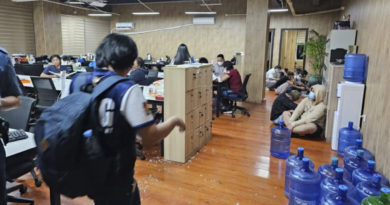ASIA-WUXI, China : TECH – Rise of the supercomputers: Developing software, talent are key challenges for China
.
WUXI, China (The Straits Times/ANN) – Asia is racing ahead to build the fastest and most powerful computers in the world. The Straits Times looks at how China is flexing their muscles in the supercomputing arena.
Despite being a relative latecomer in the world of supercomputing, China has become a powerhouse in the field, overtaking the United States in speed and in numbers.
The country now has the world’s fastest and second fastest supercomputers. It also claims 202 of the top 500 fastest machines in the world, outstripping the US with the highest number of supercomputers in the latest TOP500 survey announced last November.
The US, in second place, has 143 systems on the list. Japan was third with 35 supercomputers and Germany fourth, with 20.
“China’s supercomputers developed very rapidly, especially in the past 10 years,” said Dr Gan Lin, 29, the assistant director of China’s National Supercomputing Centre in Wuxi, eastern China.

.
It is home to Sunway TaihuLight, the world’s fastest supercomputer. Known in Chinese as “Shenwei, Taihu zhi guang” or “Divine power, the light of Taihu Lake”, the machine has the ability to perform at 100 petaflop, or 100 quadrillion operations in one second.
The supercomputer occupies four floors in the building, with its main processors on the first floor, and an electricity system and a water system in each of the two basement floors below it. On the fifth floor, there is a cooling tower. Researchers and visitors are required to don anti-static suits and put on dust covers for their shoes to enter the 1,000sq m computer room on the first floor.
To put the computer’s power in perspective, Dr Gan explained, “Assuming that everyone on earth is given one calculator each, something that the Sunway TaihuLight takes one minute to compute will take all 7.2 billion people 32 years to compute collectively.”
He told The Straits Times that China started its supercomputing programme in the early 1980s after the country opened its economy.
Under the 863 programme, a government-sponsored national initiative started in 1986 for China to develop its own cutting-edge technology, the Ministry of Science and Technology had stipulated a two-pronged approach to developing its supercomputers.
One was to import advanced computer chips from abroad to build supercomputers, which was the technology behind Tianhe-2, the world’s second fastest computer.
The second was to build a fully home-grown supercomputer using made-in-China computer chips. This approach became the focus after a ban by the US government on the export of advanced computer chips to China in 2015, over concerns of their use in nuclear tests. That helped spur the birth of Sunway TaihuLight, which cost 1.8 billion yuan and took two years to develop.
“The development of supercomputers was completely in line with our country’s economic development,” said Dr Gan. “In the past 20 years, as China’s economy has taken off in a big way, technology has also advanced rapidly and, along with it, supercomputers.”
The immense resources the government has poured into this area cannot be ignored. In the past decade, it has ramped up investments in research and development at a rate much faster than in the US and the European Union, according to a recent study by Brugel, a Brussels-based economic think tank. Chinese government spending now accounts for about 20 per cent of the world’s total spending in Research and Development in science and technology, just behind the US and the EU.
Last year, the Chinese government announced detailed plans to become the world leader in artificial intelligence (AI) and machine learning by 2030, which will create an industry worth 1 trillion yuan.
The country is now also racing against the US, the EU and Japan to develop the world’s first exascale supercomputer, which will be 10 times faster than Sunway TaihuLight.
Supercomputers can be used to foretell the future, and reconstruct the past, said Dr Gan.
“In the skies, we could predict the weather. Below the surface of the earth, we could figure out its structures, which is useful for the exploration of petrol and natural gases.”
Today, supercomputers are used in China for forecasting weather. Their immense computing power can also make complex calculations for developing nuclear weapons, going to outer space, designing cars, ships and planes, predicting earthquakes and more.
But for all its supercomputing prowess in terms of hardware, China still lags behind the US and Japan in terms of software applications.
Dr Cao Jianwen, a researcher at State Key Laboratory of Computer Science at the Chinese Academy of Sciences, told South China Morning Post that speed is not everything when it comes to supercomputers. “The machines are ultimately made to realise programmes designed by humans. Owning the fastest supercomputers lays a good foundation for China to catch up, but it could take another decade to see how China can maximise their use. “
.
COURTESY:
The Borneo Bulletin /
The Straits Times/ANN
Chong Koh Ping
>
NOTE : All photographs, news, editorials, opinions, information, data, others have been taken from the Internet .. aseanews.net | [email protected] |
For comments, Email to :
JARED PITT | [email protected] | Contributor









